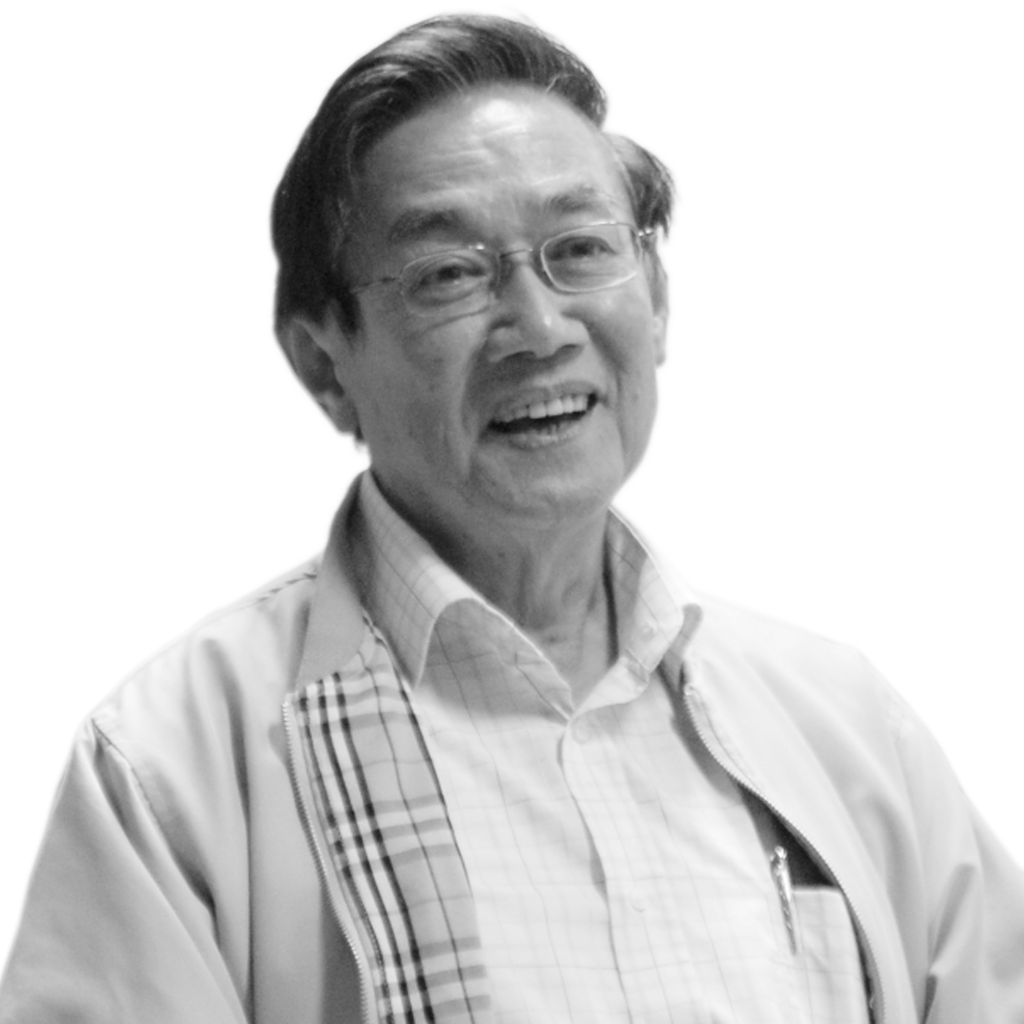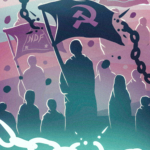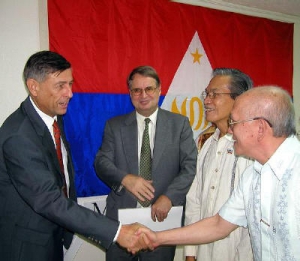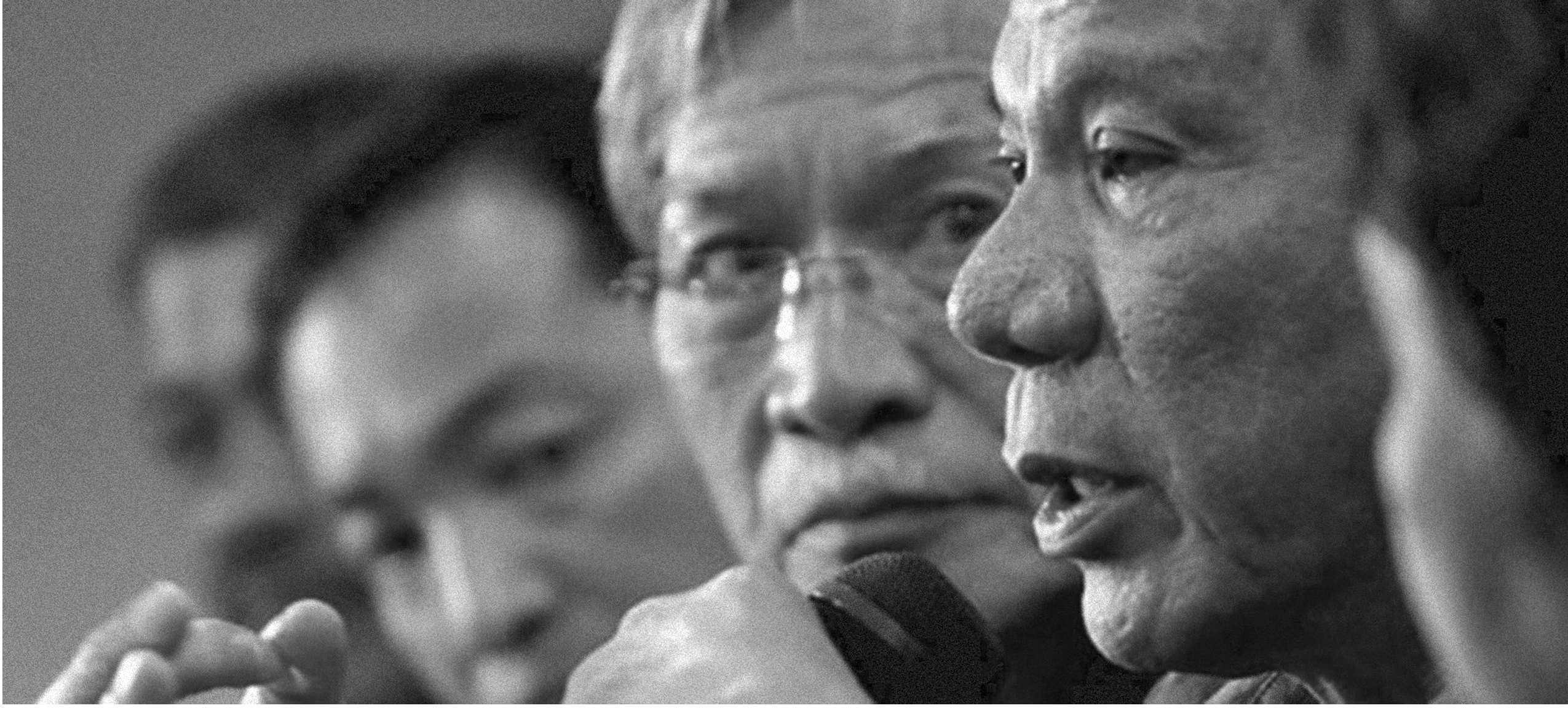Peace (Talking) Heads [Part 2 of 3]

by the Liberation Staff
An Interview with Satur Ocampo, Luis Jalandoni, and Fidel Agcaoili
Through the decades of the National Democratic Front of the Philippines (NDFP) engagement with the Government of the Republic of the Philippines (GRP) across the negotiating table, its peace panel has been successively headed by three of the movement’s comrades of unquestionable integrity and reliability—Satur Ocampo, who headed the first negotiating panel in 1986; Luis “Louie” Jalandoni who was chief negotiator from 1994 up to 2016; and, its current chief, Fidel Agcaoili who took over in 2016 when Jalandoni resigned. The three comrades, along with the other members of the peace panel, have become the personification of the NDFP through the highs and lows of the peace negotiations.
The peace negotiating panel serves as the channel and articulator of the positions defined by the leadership of the revolutionary movement. The panel members, especially the chief negotiator, are the face and the voice of the movement.
Liberation sought the three comrades to get their views on the regimes they have dealt with either as panel heads, panel member or as an “observer”.
Ka Louie Jalandoni and Ka Fidel Agcaoili were interviewed two weeks before the scheduled fifth round of talks, which the GRP cancelled in May 2017. Ka Satur Ocampo was interviewed in June, a week after the fifth round of talks was cancelled. The interview dates should be noted as they provide the context of their responses.
Since the interview, several events have already transpired. These events include the cancellation of the back-channel talks scheduled in July before Duterte’s second State of the Nation Address (SONA), the consequent threat to terminate the peace talks and the withdrawal of bail granted to former political prisoners who are participating in the talks as consultants, the extension of martial law in Mindanao, and the threat to bomb Lumad schools, among others. (Louie Jalandoni added his comments on these events in his interview.)
During their separate interviews, the three recalled what each thought was a historic moment in the talks, their frustrations and hopes, lessons and insights in dealing with the various GRP regimes, which also reflected the shifts in the peace negotiations.
From the point of view of the National Democratic Front of the Philippines (NDFP), the peace negotiations with the reactionary government are deemed as part of the total conduct of the revolutionary struggle – which essentially is “a struggle for just and lasting peace because it strives to solve the fundamental problems of the people”. Which is why, since 1986, the mutually agreed starting point of the GRP-NDFP peace talks has been to “address the root causes of the armed conflict”.
Satur Ocampo, first NDFP Peace Panel Chairperson, 1986
LOUIE JALANDONI
Liberation: How are you after the NDFP peace panel accepted your resignation as chairperson?
Luis Jalandon (LJ): I’m okay, (laughs). I am more relaxed because comrade Fidel Agcaoili, the new chairperson of the negotiating panel, now takes care of the many details involved in the peace talks. But I am still very active. I am invited in a number of forums and interviews by the media if they want to know the latest developments in the peace talks. We are now preparing for the fifth round of talks so I have to attend a number of preparatory meetings.
I am still very active, but with less responsibilities (laughs). Ka Fidel is doing a very good job, he is very well qualified.
L: What exactly is the role of the peace panel chair?
LJ: The chairperson of the panel plays a significant role as he directly negotiates with the chair and the whole panel of the GRP. He also provides guidance for the whole delegation of the NDFP, which is now more than 50 persons. The delegation is composed of the panel members and staff, the lawyers, the panel consultants and the other working committees.
The working group of the NDFP CASER (Comprehensive Agreement on Social and Economic Reforms) has the biggest delegation, around 25-30 people because this agreement will constitute the meat of the peace talks. The issues tackled in the CASER are what we call the roots of the armed conflict.
The panel chair is also involved in media work. It is his task to talk to the members of the media before, during, and after every round of the talks. The consultants assist the chairperson, like Ka Joma (Jose Maria Sison), who is deeply involved in the talks as chief political consultant. But the whole delegation and the team are the responsibility of the panel chairperson.
 L: What does a “senior adviser” do?
L: What does a “senior adviser” do?
LJ: As senior adviser, I participate in the preparation of the talks. I help in the preparation of the statements issued by the negotiating panel and take part in the discussions of the GRP-NDFP joint statements. I also talk to the media. Or, the panel includes me in the discussions and deliberations on proposals from the GRP, like for example the Trust Fund for Development similar to the Bangsa Moro Development Agency. So, the NDFP still avails of my more than 20 years of experience as chair of the negotiating panel.
L: How long was your stint as NDFP panel chair?
LJ: I was appointed chairperson of the NDFP panel when it was constituted in 1994. So, from 1994 to October 2016, that makes it 22 years. But if you include our involvement, Ka Joma and I, also with Mang Apeng Yap (deceased Rep. Jose Yap of Tarlac), when we were still exploring the possibilities of a peace talks in 1989 to 1992 during the time of Corazon Aquino, that would be 27 years.
During those years, I was involved in the crafting of The Hague Joint Declaration (THJD), and was a signatory too, with Mang Apeng. But, of course, Ka Joma and the late Atty. Romy Capulong and many others helped in drafting the framework agreement (THJD). The agreement spells out the four substantive agenda of the peace process to address the roots of the armed conflict.
L: You have negotiated with five to six regimes, from Presidents Ramos to Aquino. How would you differentiate negotiating with each?
LJ: There were 10 agreements signed under the regime of Fidel Ramos. The GRP and NDFP panels also signed the Comprehensive Agreement on the Respect for Human Rights and International Humanitarian Law (CARHRIHL), the first of the four substantive agreements. Although Ramos was not able to sign or approve it.
It was President Joseph Estrada who signed the CARHRIHL. But it was also he, who scuttled the peace talks on May 31, 1999 after the NDFP condemned the approval of the Visiting Forces Agreement (VFA). Peace consultant Vic Ladlad was arrested and detained almost a month later on June 21, which was in violation of the JASIG.
Gloria Macapagal-Arroyo (GMA) for her part took a positive step when she resumed the peace talks and reinstated all the agreements cancelled by the previous regime. She also agreed with the participation of the Royal Norwegian Government (RNG) as third party facilitator. In 2001, the peace talks resumed in Norway. In 2004, two Oslo Joint Statements were signed by the GRP and NDFP. So, give credit to GMA for these. But we also saw the worst human rights situation under GMA—more than 1,200 victims of extrajudicial killings and more than 200 victims of enforced disappearances and other cases of human rights violations. This was the time when Gen. Jovito Palparan was running wild with violations, but he was praised and promoted by Pres. Arroyo.
Ay, nothing happened during the time of Noynoy Aquino! We met in 2011 but President Aquino, Alex Padilla (then head of the GRP panel) and Teresita Deles (presidential peace adviser) attacked the framework agreement—The Hague Joint Declaration—as a “document of perpetual division”, also essentially attacking the agreement on the substantive agenda and the principle of reciprocity and non-capitulation, no surrender. They attacked the JASIG and declared it “inoperative”. They also called the CARHRIHL as an NDFP propaganda document. So, nothing really happened during the time, except for the GRP attacks on the previously signed and reaffirmed documents.
And then came the Duterte administration. Pres. Duterte at the start pushed for the peace talks; he was willing to release the NDFP jailed consultants who had been highly wanted by the military—the likes of Benito Tiamzon, Wilma Tiamzon, Tirso Alcantara, Alan Jazmines. All of them were released. There were 19 of them released so they could participate in the talks. But there are still others who are still in jail like Ed Sarmiento, Leopoldo Caloza, all NDFP consultants who were convicted to life imprisonment. Up to now they are still in jail. A third one, Emeterio Antalan was recently released.
A week after his election, on May 16, 2016, Pres. Duterte even told Fidel Agcaoili that the best way to release the more than 400 political prisoners is through a general amnesty. Now, that’s taken as very important. The release of the more than 400 political prisoners also means respecting and implementing the CARHRIHL that says all political prisoners—who had been charged, arrested or convicted of common crimes like murder, arson, robbery in contravention of the political offense doctrine—should be released.
So, that’s basic, because the first substantive agreement between the GRP and the NDFP, the CARHRIHL states that political prisoners charged with trumped up criminal charges should be immediately released. That’s one important issue that the NDFP should strongly demand from the GRP. It is very important for the NDFP to put this on the front part of the agenda of the talks.
Anyway, there is a potential for achieving a just peace within the time of the President Duterte. But we also see that there are problems and obstacles that we have to overcome—the mass movement, armed struggle, people’s war and the whole of the revolutionary movement. We need to be guided and stand firm on the demands of the people in the course of the peace talks.
Since July 19, 2017 there has been a very rapid deterioration in Duterte’s stand on the peace talks with the NDFP. He abruptly cancelled the scheduled back-channel talks, declared once more that he no longer wants to talk with the NDFP. He has repeatedly attacked the revolutionary movement. He has also been personally attacking Prof. Jose Maria Sison. The NDFP National Executive Committee has exposed in August 2017 an assassination plot against Prof. Jose Maria Sison. On the ground, numerous human rights violations are committed by the AFP, PNP and paramilitary groups.
However, Secretary Silvestre Bello, GRP Panel Chair, says that President Duterte has not issued a written notice of termination of the JASIG and therefore the peace negotiations are not terminated and the JASIG remains valid and effective. This is a remaining possible opening for the resumption of peace talks.
L: Which of the regimes you negotiated with is your personal “favorite”?
LJ: (Laughs). Well, during the time of President Ramos, he had committed many negative things against the people. But as far as the peace talks went, we were able to sign 10 agreements. So, in terms of peace negotiations, there was undeniably an advance under his term. Even the panel members he appointed moved the talks forward. In a sense, we were able to show that signed agreements are possible between the GRP and the NDFP.
Pero ngayon, siguro the most exciting would be negotiating with the Duterte regime because there are direct connections and negotiations. Very interesting, ‘no? There are exciting potentials, but at the same time, there are dangers and problems and negative points that have come up like what I stated above.
We can’t allow the human rights violations to continue. The CPP had earlier said that more than 500 barangay throughout the country are under attack by the military in violation of its own ceasefire. We have submitted a list of these violations to the GRP peace panel in April but no concrete action has been undertaken.
As a matter of fact, after President Duterte emotionally reacted and cancelled the talks, Defense Secretary Lorenzana seized the moment to declare an all-out war against the revolutionary movement. He even insulted, called us criminals and thugs. President Duterte did not stop the all-out war, it still continues—the bombardment, killing of leaders.
The GRP has put aside the most essential issues and the respect and implementation of the CARHRIHL. The government is only interested in the bilateral ceasefire. But how can we have a ceasefire if they keep putting aside the most essential part of the talks, the implementation and respect of CARHRIHL? The masses are demanding to stop these violations, otherwise the talks can not continue. We should bring back the focus of the talks on the implementation of CARHRIHL.
It is important to bring out the reports on the experiences of the masses, not only in Mindanao but all over the country, and to give proper attention and concrete actions on these violations. ‘Yan, I think that’s the most important now.

L: Which regime was the most difficult to deal with?
LJ: I had the most negative experience with the Noynoy Aquino regime. At the start, it seemed positive. In 2011, we had a ceasefire during the talks itself, ‘no? But during that round, the Aquino regime attacked the whole framework of the peace negotiations. So, from the very start, on the first day, they already said “we reaffirm the previous agreements with reservation”. Then they said that The Hague Joint Declaration is a “document of perpetual division”. So we had to go and counter this effectively because they were attacking the framework agreement. That took a lot of time during the peace talks. The GRP kept insisting to put this on record. So, we also had to put on record our counter to that.
Second, they later attacked the JASIG and declared it inoperative. It was Alex Padilla (then GRP panel head) who declared it, taking away the basic protection, including protection from arrest, of all those participating in the peace talks.
Then they called the landmark agreement, the first substantive agenda that was signed in 1998, the CARHRIHL as simply a propaganda document of the NDFP, like it was not a valid and effective agreement between the GRP and the NDFP.
On the ground, the Noynoy Aquino regime also dispensed with the rights of the farmers, like those in Hacienda Luisita, as though the massacre did not happen. It also violated its own ceasefire and claimed that the military operation was for “peace and development”.
We demanded that there should be an expressed prohibition of civil-military operations, but Alex Padilla gave explicit permission to continue the civil and military operations on the ground.
Our comrades in the field said “alkansi kami dyan” (we are at the losing end) because these so-called civil-military operations are actually offensives.
L: What are your insights in negotiating with the GRP?
LJ: At the time of Ramos, in 1996, we already had a draft agreement on CARHRIHL. The committee had three members from the GRP and three from the NDFP. When the GRP submitted the draft to their principal, it did not come back till a few months after. And when we saw the draft, it was cannibalized—almost 80 to 85 percent of the original draft agreement was gone. Drafting CARHRIHL’s preamble already took us a week. I said, “kung ganito ang ginagawa nila, pwede nang ibasura itong talks. Oo.” (laughs). (if they continue doing this, then we can just dump the talks.)
But, Ka Joma and Atty. Romy Capulong were a big help in crafting an acceptable agreement to both panels, reformulating content, but with the same substance that both sides could agree on. That was an achievement. There I realized that both sides could agree despite the difference in standpoint and viewpoint.
And so we can say that with persistence, perseverance and using all our capabilities, we did it. Also, to a certain extent, our counterparts, Mang Apeng Yap, Bebot Bello, and Rene Sarmiento were also open and willing to concur. So the draft was done and later signed into a formal agreement.
Ako, on my own, “nasabi ko napaka-walanghiya naman nitong nasa GRP side dahil meron nang agreement na-cannibalize pa.”
They did the same thing with the drafting of JASIG. We talked about it lengthily. We formed a committee composed of three members from each side. The committee discussed the draft from evening to dawn. Then when they returned, they said they already had an agreement. We were all so happy. One of us said, “It’s too good to be true, usually it is not true.”
The draft was going to be presented in the morning, but Amb. Howard Dee, the former GRP panel head, postponed it twice. When we finally met late in the afternoon, Dee stood up and declared the talks collapsed. (laughs) We can’t do anything. E, di babay na. This was October 1994. The following day, early in the morning, Mang Apeng (Yap) called for a breakfast meeting with Bebot Bello. They said they didn’t know that Amb. Howard Dee would collapse the talks (laughs). Later, we learned that Pres. Ramos reprimanded Amb. Dee for what he did, saying Dee had no authority to collapse the talks. After that, the drafting of JASIG proceeded and for more than a month, we produced 24 drafts and counter-drafts. By February 1995, JASIG was approved.
Well, there were many instances that we could overcome obstacles as long as we persisted.
L: What personal lessons did you pass on to the new peace panel chairperson?
LJ: We often have meetings. So, that’s one venue for us to talk about things and I make suggestions. Fidel (Agcaoili) is good, he is good at delegating tasks, which is necessary at this time because compared to the previous talks, this one is more complicated. The delegation of both panels is bigger than the previous talks. So there are so many committee meetings.
It is always a challenge for the chair to organize his time, to give sufficient time for collective discussions when important things come up and to listen to many views and opinions. I think Ka Fidel has the capability, he has been with the peace talks for a long time and he has a sharp mind.
L: During the announcement of your retirement as Chair of the NDFP peace panel, there were jokes, especially from the GRP panel, comparing you and Fidel—you as “diplomatic” and Fidel as “hardline”. What do you say to this?
LJ: As a matter of fact, Fidel has very good rapport with GRP panel members— with Bebot Bello, with Nani Braganza, with Jess Dureza. He is actually more effective in dealing with people because he easily establishes rapport. He has remained cool and calm during all these negotiations. Pero, of course, it’s very hard for the chair to give time to everyone. He has to deal with the time pressure during the peace negotiations on top of everything and everyone needing his attention.
[Ka Fidel as “hardline”] It’s just a perception, which probably was a result of his heated exchange with then GRP panel chair Alex Padilla during the time of Noynoy Aquino.
L: How would you describe your 22 years as panel chair?
LJ: Sa tingin ko naman, I enjoyed the challenge.
Considering all, I felt assured and confident with the support of the other kasamas (comrades)—Ka Joma was there, Atty. Romy Capulong, Fidel, the other members of the panel. Plus of course, ahh, when you meet Ka Satur (Ocampo) you always feel his support borne out of his experience.
At the same time, I would say that the most essential part for me was my integration with the masses, say in Paquibato. My visits in some guerrilla fronts and in the picketlines of workers were valuable to me. The visits keep me grounded on the people’s demands and to always have in mind their welfare and their best interest. My integration with them and seeing that the revolution continues to advance give me the strength and confidence in my work as a negotiator.
So, collective work. I don’t think I will survive the work without the collective. There is my immediate collective and the bigger collective, which is the grassroots. They were my source of strength. Together, we were able to overcome hurdles. The comrades were there, easy to consult, easy to contact. So, 22 years… ewan ko, parang ganun ang nakikita ko (that’s how I see it).
L: What did you enjoy most in those 22 years?
LJ: Ay, yung sa peace negotiations? Probably when The Hague Joint Declaration and the CARHRIHL were signed, when JASIG was signed.
During those 22 years I also had the chance to visit the countryside, which provided me inspiration, strength, ‘no? When you’re with the masses you feel the dynamism of the revolutionary struggle, of the revolutionary movement and it gives you confidence, especially when you’re in the guerrilla fronts. I also enjoyed attending forum of various sectors or joining mass actions.
When Ka Coni (Ledesma) and I attended the 48th anniversary of the CPP and the Peace Summit last December 26 in Davao, certain thoughts occurred to me amidst the masses. There were around 15,000 of them. And being with the NPA members, the members of the Pulang Bagani Battalion, it became very clear that we need to continue to fight for the rights of the workers and peasants, to assert the essential role of the NPA in building organs of political power, and that the NPA should never surrender and instead defend the masses and fight for their demands. So, napakahalaga ngayon na mapakinggan yung sinasabi ng masa na kailangan na ipagpatuloy ang pakikipaglaban. (It’s very important to listen to the masses to pursue the struggle.)







 L: So you were still in jail when Ramos became president?
L: So you were still in jail when Ramos became president?
